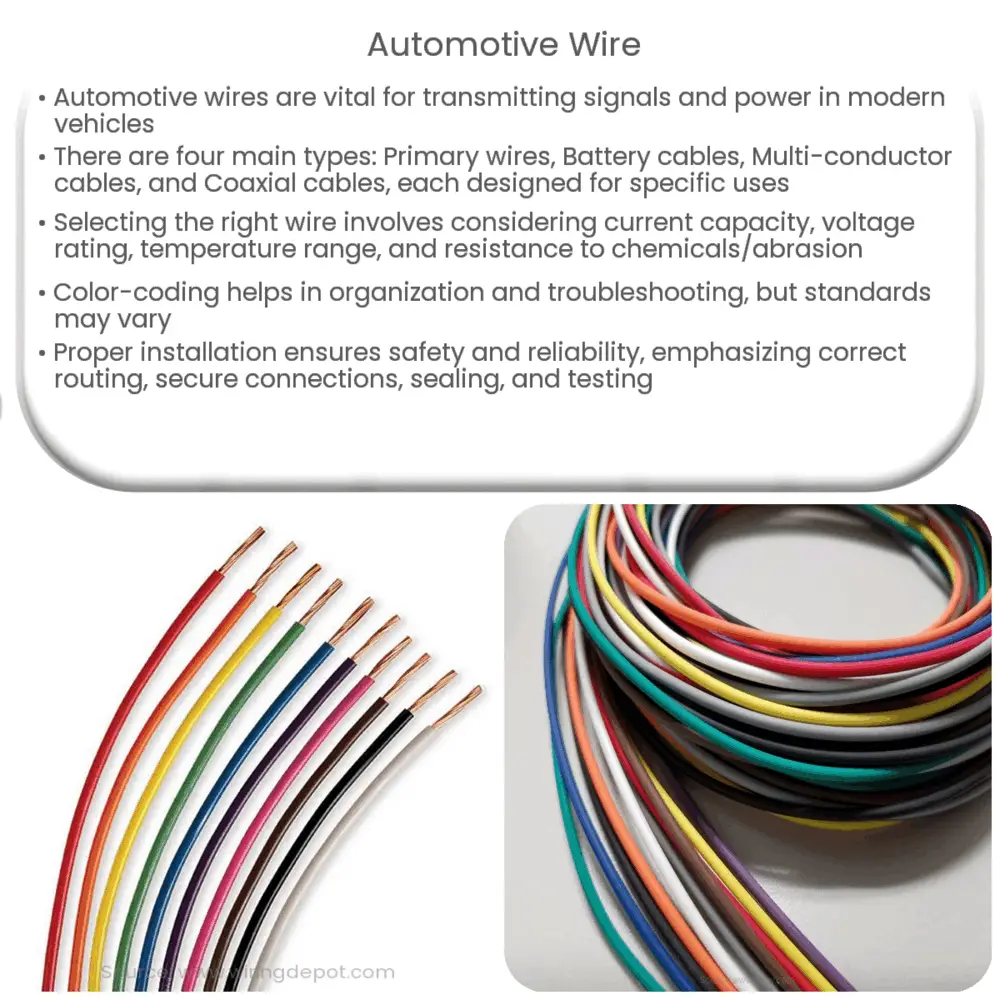Automotive wires transmit power and signals in vehicles, with various types suited for specific applications. Proper selection and installation ensure safety and reliability.

Understanding Automotive Wire: A Comprehensive Guide
Introduction
The automotive industry has evolved significantly over the years, with modern vehicles boasting advanced electronic systems that control everything from engine performance to in-car entertainment. At the heart of these complex systems are automotive wires, responsible for transmitting electrical signals and power throughout the vehicle. In this article, we will explore the various types of automotive wires, their functions, and best practices for selection and installation.
Types of Automotive Wires
Automotive wires can be broadly categorized into four main types, each designed for specific applications and environments. These include:
- Primary Wires: Also known as general-purpose wires, primary wires are single conductor wires used for low-voltage applications in automotive electrical systems. They are typically insulated with materials such as PVC, cross-linked polyethylene (XLPE), or thermoplastic elastomer (TPE) to provide resistance to abrasion, heat, and chemicals.
- Automotive Battery Cables: These heavy-duty cables are specifically designed to transmit power from the battery to the vehicle’s starter, alternator, and various other electrical components. Battery cables are typically made from copper or aluminum and feature a thick insulation layer for protection against high currents, heat, and mechanical stress.
- Automotive Multi-conductor Cables: Multi-conductor cables consist of several insulated conductors bundled together within a single cable jacket. These cables are used for applications that require multiple circuits, such as wiring harnesses, control panels, and sensor systems. They often include shielding to reduce electromagnetic interference (EMI) and improve signal integrity.
- Automotive Coaxial Cables: Coaxial cables are designed for high-frequency signal transmission in applications like GPS, radio, and video systems. They consist of a central conductor surrounded by a dielectric insulating layer, a shielding layer, and an outer jacket. The shielding layer helps prevent EMI and maintain signal integrity.
Choosing the Right Wire for Your Application
Selecting the appropriate automotive wire involves considering several factors, such as the specific application, electrical requirements, and environmental conditions. Key factors to consider include:
- Current Capacity: Choose a wire gauge that can handle the maximum current expected in your application. Higher current capacity requires thicker wires.
- Voltage Rating: Ensure that the wire insulation material can withstand the voltage levels of your system. Voltage ratings vary depending on the insulation type and thickness.
- Temperature Range: Automotive wires are exposed to varying temperatures, both during operation and while parked. Select wires with insulation materials that can withstand the temperature range expected in your application.
- Chemical and Abrasion Resistance: Wires may be exposed to chemicals such as oil, fuel, and coolant, as well as physical abrasion from vibration and movement. Opt for wires with suitable insulation materials that offer resistance to these factors.
Wire Color Coding and Standardization
Automotive wire color coding is essential for the organization, identification, and troubleshooting of electrical systems in vehicles. Different countries and manufacturers may follow various standards, but some common color-coding practices include:
- Ground Wires: Usually black or green in color, ground wires are crucial for completing electrical circuits and maintaining safety.
- Power Wires: Red or yellow wires typically carry power from the battery or fuse box to different electrical components.
- Accessory Wires: Accessory wires, often blue or purple, provide power to auxiliary systems like audio, lighting, and power windows.
- Signal Wires: Signal wires, responsible for transmitting information between sensors, controllers, and actuators, may come in various colors, depending on the system and manufacturer.
It’s essential to consult your vehicle’s wiring diagram or manufacturer’s guidelines to understand the specific color-coding system in use.
Best Practices for Automotive Wire Installation
Proper installation is crucial to ensure the reliable and safe functioning of automotive electrical systems. Here are some best practices to follow:
- Routing: Route wires away from sharp edges, moving parts, and heat sources to prevent damage. Use cable ties, clamps, or conduit to secure and organize wires.
- Connections: Use high-quality connectors and crimping tools to create secure, corrosion-resistant connections. Avoid using wire nuts or electrical tape, as they can lead to unreliable connections and potential safety hazards.
- Sealing: Apply heat shrink tubing or liquid electrical tape to seal connections, protecting them from moisture, dust, and corrosion.
- Wire Size: Select the appropriate wire gauge for your application to prevent voltage drop, overheating, and other issues that can result from using undersized wires.
- Testing: After installation, test the entire electrical system to ensure proper function and identify any potential issues.
Conclusion
Automotive wires play a crucial role in modern vehicles, powering complex electronic systems that enhance performance, safety, and convenience. Understanding the different types of automotive wires, their functions, and best practices for selection and installation is essential for maintaining reliable and safe electrical systems. By following the guidelines presented in this article, you can ensure that your vehicle’s wiring is both effective and secure.

